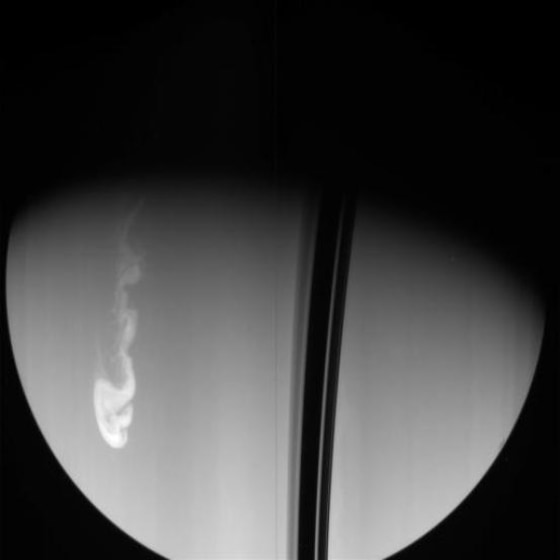So you think this week's East Coast snowstorm is a biggie? Get a load of the monster storm system that astronomers are seeing on Saturn. Some astronomers have suggested that this is shaping up as a "Great White Spot" — a rare occurrence on the ringed planet — and now the Cassini orbiter has gotten its first good look at the phenomenon.
"Just down on the ground today ... our cameras on Cassini have captured sight of a gigantic storm recently erupted in the northern hemisphere of Saturn," the Space Science Institute's Carolyn Porco, who leads Cassini's imaging team, wrote in an e-mail advisory. "This storm has been sighted by the amateurs in recent weeks, but Cassini was finally in a position to take a splendid series of pictures of it. And what a storm it is! ... It only goes to show: It pays to have a sophisticated observatory in orbit around Saturn."
Australian amateur astronomer Anthony Wesley was among the first to catch sight of the storm, and shared a picture of it last week. Another accomplished amateur, Chris Go, sent in a picture from the Philippines. And still more pictures are coming in to UnmannedSpaceflight.com's Saturn forum.
In her report for Universe Today, Nancy Atkinson quoted Wesley as saying that this is the "brightest Saturn storm in decades."
"If you get a chance to see it visually, then take it," Wesley said in his forum post, "it may be one of the rare 'Great White Spot' outbreaks on Saturn. Personally, I think it's just jealous of its big brother for taking all the attention lately."
Wesley is referring to the storm activity on Jupiter, which he and Go have had a hand in documenting. Most recently, astronomers have been noting the reappearance of the giant planet's Southern Equatorial Belt, a stripe of clouds that faded from view several months earlier.
If this flare-up on Saturn really does qualify as a Great White Spot, that could add a fresh twist to a long-simmering mystery: Why and when do such storms arise? The "Spot" storms are thought to be caused by an dramatic upwelling of material from lower levels of Saturn's atmosphere, perhaps related to thermal instability. They can become so powerful that the spot stretches into a stripe, lengthening enough to encircle the planet.
The current thinking is that classic Great White Spots occur roughly every 27 to 30 Earth years, in sync with Saturn's seasonal cycle. The last major occurrence was recorded in 1990, although "Spot" phenomena have also been seen in 1994 and 2006.
Based on that schedule, some astronomer weren't expecting another classic GWS until 2016 or so. In the weeks to come, Saturn-watchers will be watching this mega-storm to see whether it turns into a great ... or a not-so-great ... white spot. You can follow along by checking in with the Cassini imaging team's website, NASA's Saturn Web portal, and UnmannedSpaceflight.com.
More about Saturn and storms:
- Saturn's hexagon, and other strange shapes
- Giant blizzard rages on Saturn
- Happy holidays from Saturn's moons
- How Jupiter changes its spots
Connect with the Cosmic Log community by hitting the "like" button on the Cosmic Log Facebook page or following msnbc.com's science editor, Alan Boyle, on Twitter (@b0yle).
